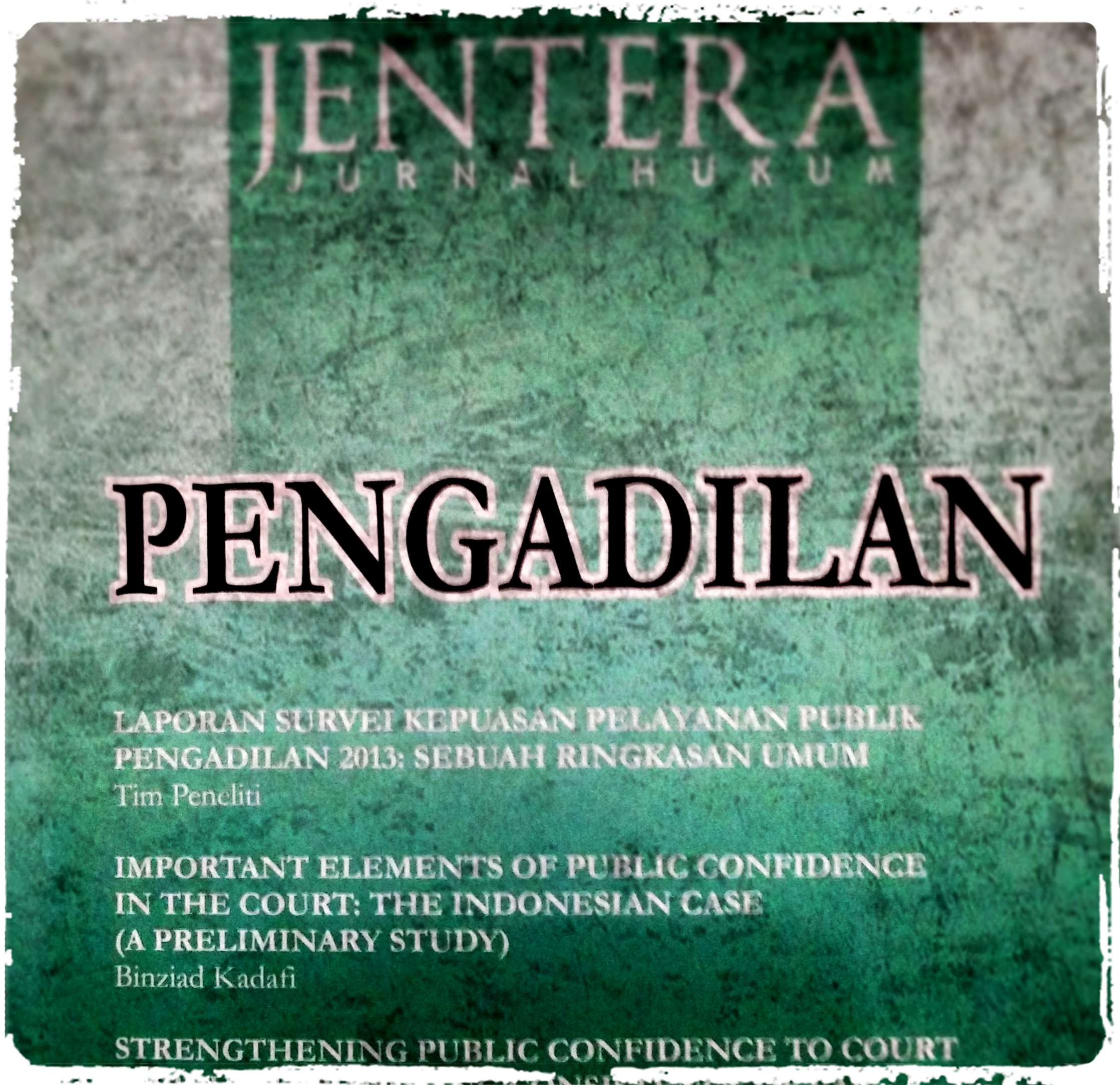
by Binziad Kadafi
The courts and the public trust
Discussion regarding the trust or distrust of the courts is not something new. Roscoe Pound raised the issue more than 100 years ago, in a famous speech he made before the American Bar Association meeting in 1906.[1] It could be said, hence, that the discussion of this problem might be as old as the law itself.[2]
The question is why is public confidence in the courts so important? Already discussed a century ago and we are still talking about it today? The best answer to this is the strong belief shared by many of us that the power of the courts lies mainly in public trust. That is why the judiciary is often referred to as “least dangerous” branch of government as it has neither the power of budget (“purse”) that the legislative branch has nor the coercive power (“sword”) held by the executive branch.[3] Ultimately judicial power rests on substantial public confidence in its moral sanction.[4]
The judiciary has only the trust and confidence of the public and the grounding of the rule of law to produce respect for its judgments and decrees.[5] The respect accorded to judges depends on the way they meet the expectations of fairness and justice, which individuals (public) have of them and on the substantive values which their decisions and procedures promote.[6]
Public trust is indeed considered important by the Indonesian courts. In a keynote speech at the closing of a national working meeting of the Indonesian Supreme Court (Mahkamah Agung Republik Indonesia) in 2011, the then Chief Justice, Dr. Harifin Tumpa, for several times stressed on the importance of public confidence in the courts.[7] Harifin Tumpa appealed to hundreds of judges attending the meeting that good decisions must continue to be advanced, as they contribute to the growth of public confidence in the courts.[8] One of the ways of doing so, according to Harifin Tumpa, is by implementing the chamber system, which is expected to increase public confidence in the judiciary through increased consistency in the use of legal concepts.[9]
In his speech, Tumpa even went so far as to challenge whoever his successor would be, to have the passion and courage to keep on the independence of the judiciary, so as to regain the public trust that has long faded.[10] Through such a challenge, Tumpa deliberately raised the strong link between public confidence in the courts and the principle of independence (as well as accountability) of the judiciary as set out in Indonesian constitution and all legislation on judicial power. Such a linkage was also notably observed by E. Norman Veasey, Chief Justice of the Delaware Supreme Court, United States, in his keynote address to a bench-bar conference held in 2000.[11] He asserted that the courts has only one constituent, namely the “rule of law”.[12] He also expressed the view that judicial independence is not the judge’s property, but the property of the people, an asset held in trust.[13] Likewise, judicial accountability is the right of the people.[14] The judges are, in Veasey’s view, the trustees of that trust and required to preserve and manage it well through proper action and appearances, not on occasion or when convenient, but all the time.[15]
In Indonesia, the issuance of the Joint Decree of the Chief Justice of the Supreme Court and the Chairman of the Judicial Commission (Komisi Yudisial) on Judicial Code of Ethics and Code of Conduct (Kode Etik & Pedoman Perilaku Hakim/KEPPH) in 2009, marked the increasingly institutionalized efforts to gain public trust. Achieving public confidence would no longer just be the agenda of the courts, but also belongs to its constitutional counterpart, the Judicial Commission, which subsequently forwarded the agenda to the judges through the implementation of standards of proper behavior.
The general provisions of the KEPPH provide that the internal and external supervision of judges performed by both the Supreme Court and the Judicial Commission is oriented towards ensuring that all judges, being the primary executors of the judicial function, uphold high integrity, honesty and professionalism, so as to attain the trust of the public and justice seekers.[16] The provisions also mandate the importance of judges both inside and outside the courts to maintain and foster public confidence, as well as the confidence of the justice seekers.[17] Furthermore, in many of the articles of the KEPPH, the provisions on different attitudes of “impartiality”, “independence”, “honesty”, and “discipline” of judges are always associated with the necessity to reinforce public confidence and the confidence of justice seekers towards the judiciary.[18]
In addition to that, the current Indonesian Chief Justice, Dr. M. Hatta Ali delivered a strong argument in his address to the closing ceremony of the national working meeting of the Supreme Court in Manado in 2012.[19] The point he stressed was: “we are nothing without public confidence,” a statement that was headlined in Indonesian press reports.[20] On a different occasion, at the inauguration of twelve Heads of High Courts held at the Supreme Court on 27 December 2012, Hatta Ali said that public trust is something that is hard to get, but can diminish easily due to skepticism.[21] He asserted that years of struggle in building public confidence in the courts can be lost only in a moment, and therefore courts can no longer tolerate any improper behaviors that erode the reputation and the integrity of the judiciary.[22] The Chairman of the Judicial Commission, Dr. Suparman Marzuki, also raised the same concern on the occasion of the 9th anniversary of the Judicial Commission by stressing that the most serious problem currently faced by the courts is the lack of public confidence.[23]
Symptoms of public confidence in the courts
Despite the strong commitment made by the leadership of the Supreme Court and other members of Indonesian judiciary through numerous judicial reform programs introduced and carried out from 2000 onwards, public opinion of the courts has not changed as much as might have been anticipated.[24] Public confidence in the courts has improved, but is not yet extensive. This assessment is articulated not only by outside stakeholders, but even by the leadership of the judiciary and the judges themselves.
More empirical and therefore objective information should be used and advanced to back up any observations on the level of public confidence in the court. Some symptoms that can help to measure the state of public confidence in the courts in Indonesia are as follow.
a. The number of incoming cases
The number of incoming cases might be the most powerful indicator of public confidence in the courts. It can display whether litigation is a trusted mechanism and hence relied upon to resolve problems and disputes that emerge in the daily life of Indonesian society, in every possible sphere, not only in civil cases, but also in administrative matters.
To get a picture of the extent of judicial involvement in state administrative matters, let us take a look at the administrative courts, the most important courts for Indonesian citizens to seek redress against the government.[25] The administrative courts consist of 28 courts of first instance and 4 appeal courts, with 300 judges and 860 support staff.[26] But, on average, this system delivers only 1,704 decisions every year.[27] This is the total number for the entire country; the total number of cases filed from among 250 million citizens. In fact, regrettably we can not claim that this number is so small because Indonesians have no complaints against the bureaucracy, or because everything works well in the area of state administration and public services.[28]
The performance of the labor courts is similar. There are 33 labor courts in Indonesia, but only 749 cases were filed in these courts in 2013.[29] This is another minuscule figure, and the figure cannot honestly be explained by saying that the number is so small because Indonesian workers are all happy and satisfied, their salaries paid on time, and if they are dismissed, their severance pay properly paid.[30]
Perhaps the most telling figure that best reflects public confidence in the courts is litigation that is truly voluntary, where Indonesians go to court of their own free choice to secure their individual rights (contractual claims, torts, etc.).[31] Only 17,529 contentious civil disputes were filed in 2008 for the whole of Indonesia,[32] and 17,258 in 2013.[33] And this tiny trickle of voluntary cases was filed despite the availability of 347 (in 2008)[34] and 352 (in 2011)[35] district courts.[36] No wonder a fair share of the district courts report not getting any cases at all for the entire year – 20 courts in 2008.[37] What these figures most likely show is that when Indonesian citizens have a choice, they do not go to the courts to find justice.[38]
Such a number of voluntary civil cases is very small when compared with the number of micro, small, and medium enterprises in Indonesia, which according to the data compiled by the Ministry of Cooperatives and SMEs reached 56,5 million in 2014.[39] Civil lawsuits heard and decided by all courts of general jurisdiction in Indonesia in 2013 count only 0,03% of the population group with the most potential to bring cases.[40] That number becomes even smaller when compared to the population of Indonesia that according to 2010 data released by the National Statistics Body (Badan Pusat Statistik/BPS) had reached 237,641,326 people.[41] The comparison percentage turns out to be even lower, down to 0,007%, when the number civil claims is measured against the size of the Indonesian population.[42]
The above figures could be more meaningful if they are collated with analogous data from other time periods to see the trends of increase or decrease, accompanied by analysis and hypotheses to explain changes and fluctuations in use of the courts. Tabulation and analysis of these figures may also lead us to interesting insights on the role of courts in Indonesia if done in comparison with similar circumstances in other countries.
There must be explanations for why the number of voluntary civil cases filed by Indonesians 20 years ago was significantly higher than it is now.[43] Even in the colonial period, Indonesians filed more than 30,000 voluntary civil cases in the colonial courts – twice the number currently filed, even though there were only about 45 million Indonesians at the time.[44] If we compare the above figures to country such as Australia, it is fair enough to say that all 230 million Indonesians in 2008, and 250 million of them in 2010, filed about as many voluntary cases as a single magistrate of other country would handle in a year.[45]
b. The number of appeals to the Supreme Court
In 2003, in the blueprint for the reform of Indonesian judiciary, the Supreme Court maintained that the high number of incoming appeal cases filed at the Supreme Court suggests and is driven partly by the lack of public confidence in the decisions of first instance and appellate courts.[46] Therefore, one could say that the profile of appeal cases of either cassation or civil review (peninjauan kembali/PK) that are coming to the Supreme Court could indicate to a certain extent the level of public confidence in the courts, particularly in the decisions of the preceding level of courts.
In 2008, out of 13,543 cases that were decided by all appellate level courts in Indonesia, 11,338 went on to the Supreme Court.[47] This means that cassations were filed on 80% of the appeal court rulings in Indonesia.[48] Similar figures can also be found in the data for prior (2007) or subsequent (2009) years. In 2007, there were 12,258 cases decided by high courts in Indonesia from all jurisdictions.[49] In the same year, a total of 9,524 cases went on to cassation.[50] When these numbers are compared, one can see that in 2007 cassations were filed on 77,6% of the appeal courts’ rulings.[51] In 2009, the number of appellate decisions was 14,431 and there were 12,210 cassation cases. This comes up with a larger percentage of appeal, i.e. 84,6%.[52]
There was slight decline in this percentage comparison in 2013, although not significant enough to demonstrate any new trend. The Supreme Court annual report reveals that in 2013 there were 13,640 decisions made by all appellate courts in Indonesia, while at the same time there were 9,799 incoming cassation cases.[53] If all cassation cases filed in 2013 are assumed to derive from cases decided at the appellate level in the same year, it can be said that of 71% of appellate court rulings resulted in cassation filings at the Supreme Court.
In addition to cassation cases, civil review cases can also be referred to as another indication of the level of public confidence in the courts. In their research on case limitation supported by NLRP in 2010, a leading judicial reform NGO, the Institute for the Independence of the Judiciary (Lembaga Kajian & Advokasi untuk Independensi Peradilan/LeIP) learned that more than 90% of incoming civil review cases over a number of years were filed against the Supreme Court’s cassation decisions.[54] The rest, or about 10% of civil review cases, were filed against the decisions of first instance and appellate courts.[55] On average, between 2004-2008 (5 consecutive years), the percentage of incoming civil review cases filed against cassation decisions was 90,43%.[56]
When studied in more detail, of all the civil review cases filed at the Supreme Court, the majority were based on claims of judges’ mistakes or manifest errors in judgments.[57] Such claims fall very close to the possible considerations justice seekers would make that relate to their confidence in the courts and judges, particularly when it comes to their evaluation of the competence of judges and the courts. The number of applications for civil review reached 73,79% within 5 years between 2004-2008.[58] Only 15,67% of civil review cases in this period were based on the presence of novum (newly discovered determinant evidence that at the time of previous case examination was not known), while the remainder were based on other considerations.[59]
The appeals information can not necessarily be relied on completely in explaining public confidence in the courts, given that there are other factors that need to be considered to understand the high number of appeals. This includes litigation strategies used by the parties, which are usually facilitated by their advocates, as well as loose limitations on appeals. Nevertheless, this information can serve as a partial indicator of the level of confidence (and satisfaction) of justice seekers in court decisions or the lack thereof that serves as one of the factors motivating litigants to file legal actions (upaya hukum).
c. Potential domain of the courts
Many parties, particularly judges, believe that one of the main functions of the court is to loosen the tensions that exists in society as a result of a variety of (potential) conflicts, by channeling them to the dispute settlement mechanisms, in order to prevent the use of force (kekerasan) in sorting out the conflicts. The judiciary and its adjudication processes serve a pluralistic democratic society, not only as an independent and as impartial forum for the struggle between conflicting interests and values but also to contribute to the maintenance of the legal order and the public domain in general.[60]
National System for Violence Monitoring (Sistem Nasional Pemantauan Kekerasan/SNPK), a central database managed by the Coordinating Ministry for People’s Welfare of the Republic of Indonesia, in its monthly report in January 2014, released data on the prevalence of violence in 13 areas, including Aceh, Greater Jakarta (Jabodetabek), West Kalimantan, Central Kalimantan, East Kalimantan, Maluku, North Maluku, East Nusa Tenggara, Papua, West Papua, Central Sulawesi, Lampung and West Nusa Tenggara.[61] The data showed that from January 2013 to December 2013, there were at least 9,349 violent incidents recorded in the 13 regions above.[62] The highest number was contributed by the incidence of crimes amounted to 5,536.[63] But the number of violent incidents categorized as vigilantism (main hakim sendiri) was also significant, reaching 1,208, in addition to domestic violence (772), and conflicts over resources (332).[64]
Staggered analysis of course can be done to better understand this information. Besides the violence of the crimes, which are defined by SNPK as “actions that occur in the absence of neither previously disputed conflicts nor specific targets”, the high incidence of violence indicate that public confidence in the formal dispute resolution system (particularly the courts) has not been able to replace their preference for solving problems by violent means. To support this approach in analyzing the information, a recent doctoral thesis at the Leiden University partially confirmed that an improved public confidence in the justice system (courts), helps to reduce the potentials for the use of violent means by the public in solving their conflicts.[65]
The need for the courts to resolve disputes that arise in the community can also be reflected from the use of various alternative channels to find solutions to the legal problems they are facing. One of these conduits of public complaints against public services provided by various government entities was managed by the presidential delivery unit (Unit Kerja Presiden Bidang Pengawasan & Pengendalian Pembangunan/UKP4).[66] One of their publications points out that until May 2013, the online application for public complaints and aspirations (Layanan Aspirasi dan Pengaduan Online Rakyat/Lapor!) that is connected to more than 80 ministries and non-ministerial agencies, as well as several local governments, received 62,527 reports submitted by 22,954 members of the public, being the users of the application. The publication also highlights that 53% of the received complaints were successfully settled, while the other 25% were claimed to be in the follow-up process, and only 22% were not yet processed.[67]
Given the substance of the complaints, which generally are on governmental or state agency actions in implementing development programs and providing public services, it can be said that the domain of complaints settlement channel managed by UKP4 limitedly coincides with the domain of the courts, especially the administrative court. But through comparison of the number of the utilization of the channels by the community alone, a generic conclusion on which one is getting more confidence from the public can be effected.
Finding the causes
If we can agree that the symptoms discussed above can be recognized as signs of problems in public confidence in the courts, then the next step to be taken is to find the causes. Justice must not only be done, it must also be seen to be done. Public confidence is built by various public perceptions that emerge and live in the community about the courts. The more positive the perceptions are, the greater confidence can be expected from the public towards the court. But if the perceptions are predominantly negative, the public trust needed by the courts is at stake. Therefore, it is important to diagnose the diverse and growing perceptions in the community about the courts through appropriate sources of information.
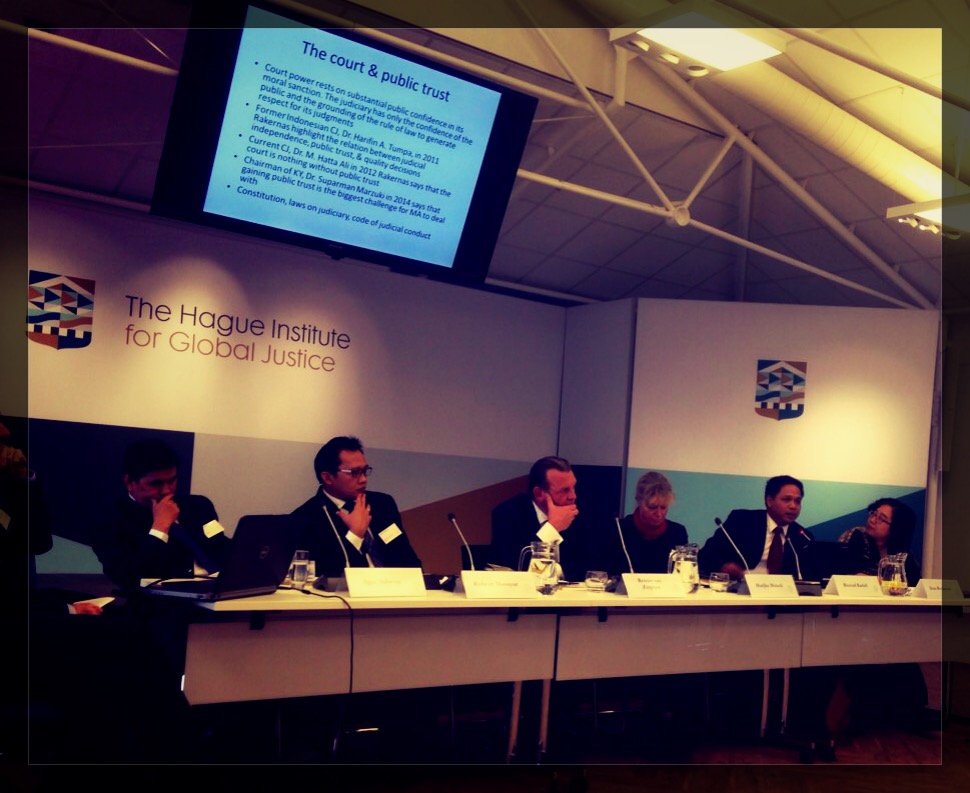 The most rich, complete, and up-to-date source of data is media spotlight. Everywhere, not only in Indonesia, including in the Netherlands, the judiciary and adjudication are the subjects of permanent attention by the media. The attention of the media towards the court in Indonesia has been augmented recently following the improved transparency of decisions promoted by the Supreme Court through its successful efforts to make the full texts of court decisions available to the public online. Many times, not only bad news, but positive appreciation towards individual judges or the court institutionally can be obtained from media exposure. However, anticipation should be made on the potential bias of certain media, especially when they have, either directly or indirectly, interests in particular outcomes from the coverage. The proper strategy in overcoming this issue is by referring to different newspapers, magazines, and electronic media as references, so their reportage can be cross-checked one against the another, and by being aware of the important role of local media, which occasionally have more direct connections to the source of the news and their audiences.
The most rich, complete, and up-to-date source of data is media spotlight. Everywhere, not only in Indonesia, including in the Netherlands, the judiciary and adjudication are the subjects of permanent attention by the media. The attention of the media towards the court in Indonesia has been augmented recently following the improved transparency of decisions promoted by the Supreme Court through its successful efforts to make the full texts of court decisions available to the public online. Many times, not only bad news, but positive appreciation towards individual judges or the court institutionally can be obtained from media exposure. However, anticipation should be made on the potential bias of certain media, especially when they have, either directly or indirectly, interests in particular outcomes from the coverage. The proper strategy in overcoming this issue is by referring to different newspapers, magazines, and electronic media as references, so their reportage can be cross-checked one against the another, and by being aware of the important role of local media, which occasionally have more direct connections to the source of the news and their audiences.
The next important data source is public statements by opinion makers from NGOs and academics, particularly those who focus on law and justice sector issues. This data usually coincides with the media news, as most of public opinions broadcast by media are still heavily influenced by the views of opinion makers, who generally are NGO activists and academics. However, more comprehensive data containing assessment, observation, and opinion on the performance and standing of the courts can many times be obtained directly from a variety of year-end reports, books, position papers, working papers, writings, or media releases published by organizations and scholars following legal and judicial reform efforts or studying the judiciary and the legal system.
Complaints made by justice seekers or litigants, either those that are channeled through alternative means such as letters to the editor or blogs, or submitted through official supervision outlets, can also be a source of useful data in identifying the public perception of the court. Let us take a look at complaints handled by the Judicial Commission. Based on its 2013 annual report, the number of public complaints on judicial conduct received directly by the Judicial Commission in 2013 amounted to 2,193.[68] The annual report states that out of 2,193 incoming public complaints, 230, or 10.48% of the complaints fall outside the authority of the Judicial Commission.[69] The majority of complaints are related to questions on the professionalism of judges (as the term used in the KEPPH), which reached 775 reports, or approximately 35% of all incoming reports.[70] The data of course tells a lot about the estimation of the judiciary in the eyes of the complainants. The reports handled by the Supervisory Body (Badan Pengawasan) of the Supreme Court or other relevant oversight mechanism (such as the National Ombudsman, etc.) could be read likewise.
The next data source is opinion and satisfaction surveys. In many countries, this kind of survey is carried out by the courts by themselves, or by third parties in cooperation with the courts, although more independent surveys are also numerous and tend to be regarded as more reliable. In Indonesia, the tendency to do this kind of survey to gauge public perceptions of and satisfaction with the services of the courts has been increasing over time. One of them is a user satisfaction survey on public services in courts that was conducted recently by a leading law reform NGO (Pusat Studi Hukum & Kebijakan Indonesia/PSHK) in cooperation with Badan Pengawasan and supported by the Australia Indonesia Partnership for Justice (AIPJ) in 2013.[71] The survey was carried out towards 1,546 court users as respondents in 12 different cities in Indonesia and disclosed that 45% of the respondents were satisfied with the services of the courts, 41% were adequately satisfied, and 14% expressed their dissatisfaction.[72]
A more independent survey carried out by Hiil, (an advisory and research institute for the justice sector, based in The Hague), in cooperation with the Indonesian Legal Aid Foundation (YLBHI) and supported by the Open Society Justice Initiative, can be posited as another example.[73] The survey, which was titled “Justice Needs in Indonesia in 2014”, involved 2,400 respondents from 5 provinces in Indonesia.[74] The report contains estimates of potential needs of Indonesians towards effective dispute resolution mechanisms. The findings of the survey indicate the expected demand for justice. According to the survey, currently there are (at least) between 6 and 9 million victims of crime who need advice, support and assistance.[75] Between 2 and 4 million people are involved in land disputes, besides 1.5-3 million who are involved in money related disputes.[76] The findings also estimates that as much as 1.4-2.9 million Indonesians are involved in neighbors’ disputes as well as another 1.18-2.5 million involved in family disputes.[77]
Another initiatives include the state of law index survey conducted by the Indonesian Legal Roundtable (ILR) in collaboration with the Indonesian Survey Institute (Lembaga Survei Indonesia/LSI), which in the very latest version asked for the opinion of hundreds of experts in different fields on the state of the rule of law in Indonesia, including the state of the judiciary[78] as well as, the survey on the integrity of public institutions that is regularly held by the Corruption Eradication Commission (Komisi Pemberantasan Korupsi/KPK), which in 2013 listed the Supreme Court as ranking the highest among 8 other institutions in terms of the integrity of its administration with an average score of 7,10.[79]
Statements by members of the judiciary in various official forums, such as in many of the public fit and proper tests during the selection process for Supreme Court justices, both those that are held in front of the Judicial Commission and before the law commission of Parliament, can sometimes offer interesting information shedding light on public perceptions of judicial performance. Even candidates who are career judges often reveal issues of public confidence during their tests, including things which may either represent their own views and observations, or the views held by the community that they have been able to record during their career in the bench.
Court decisions may also contain a great deal of opinions of the judges on the performance of other judges, particularly those whose decisions happened to be under their review, as well as the performance of their institution. A good example was the decision at the civil review level of the case between Bank America National Trust Company; Morgan Stanley & Co. Incorporated, et.al.; PT. Indah Kiat Pulp & Paper Tbk; and the Depository Trust Company, et.al.[80] The decision composed by Mariana Sutadi, Harifin Tumpa, and Paulus Lotulung (all of whom were highly respected justices), sheds light on their aspirations on the importance of chamber system, the need for a strong expertise background for judges in handling cases, and the criticism towards weaknesses flaunted by the judges at the preceding level in constructing their arguments.[81]
As far as this preliminary study concerns, the depicted perceptions derived from these various sources of data and other possible sources of data –that may be further identified and analysed– are as follows:
a. Perceptions on the cost of the judicial process
To litigate in the courts, especially in civil cases, incurs significant costs. Merely to file a lawsuit, official fees set by government regulation on non-tax revenues, decisions of the Chief Justice on court fees, and the determination of the respective Chief Judge on the advance payment of court fees, can average nearly IDR 1 million.[82] This does not include the costs of seizure, field examination, and execution (if required), for which the official charges may become significantly higher.[83] Not to mention the costs if the case should go through appeal or cassation, where each stage requires additional fees.[84] The perceptions on costly court proceedings are usually compounded and tend to be mixed up with the cost to hire a lawyer. People still tend to generalize the view that the cost for a lawyer is part of the costs to be incurred in the trial.
b. Perceptions on the integrity of the judicial process
Perceptions on the integrity of the judicial process were one of the findings of the survey conducted by the Indonesian Legal Roundtable in 2013 by interviewing experts in various provinces throughout Indonesia.[85] In the opinion of 56% of the interviewed experts, the independence of judges in deciding the case was found in only a few cases.[86] As many as 17% of the experts regarded the judges as not independent in most cases, and 5% of them gave the opinion that judges are not independent in all cases.[87] The factor considered to detract the most from the independence of judges is corruption.[88]
c. Perceptions on the consistency of court decisions
The consistency of court decisions is still an issue in Indonesia. There is shared perception that in some cases, the same type of cases can be decided quite differently, not only by different courts, but also sometimes by the same court, or even the same judge.[89] The lack of consistency has certainly become the target of public criticism, as expectations on how a case is decided, which should have referred to the earlier decisions on the same type of case, are not easy to be placated.
d. Perceptions on timeliness
Actually, there are rules and guidelines on how long it should take for a case to be resolved by the courts.[90] However, the ability of judges to follow these rules and guidelines varies, let alone the consequences of failure to adhere to stipulated time limits have not been made clear and unequivocal. Cases settlement will be perceived too long if parties takes the appeal, cassation, or civil review mechanism. It will take extra time for the decision to be enforced.
e. Perceptions on the actual resolution of disputes
It is a collective concern that when a judgment is obtained, the legal problem may still not be able to be resolved, considering the difficulties in the enforcement of the judgment. In addition to the official execution costs that are already high, challenges to the execution of a court decision will make the actual execution costs become even higher and the time to be longer. The situation is aggravated by the behavior of some state officials ignoring court rulings that have ordered corrections to their policies. This bad example of course further erodes public confidence in the ability of the courts to actually solve their problems.
f. Perceptions on the quality of public services
One aspect of public service by the courts that is frequently complained about is the scheduling of hearings. Many people complain about hearing schedules that may be delayed by a few hours or even by days, not only the justice seekers, but also attorneys or prosecutors, or the parties presented as witnesses. Indeed, the contributing parties may not only be the judges, it could be prosecutors or other parties, but the court is seen as the ultimate authority to control the proceedings of a case. The community also often feels the minimal court facilities are also troublesome, ranging from the limited number and quality of courtrooms up to the poor basic facilities such as waiting rooms and toilets.[91] The problem will become more serious when the attention is directed to the facilities for those with special needs such as women and persons with disabilities.[92] The view that the court is an uninviting public institution is still felt by many people.
g. Perceptions on commitment to reform
Despite the many reform measures undertaken by the Supreme Court and the lower courts, and although wide international recognition has been received for the reform measures taken by the Supreme Court, the public appreciation in Indonesia is still overshadowed by the unfavorable aspects of litigation that continue to diminish the credibility of the courts. The negative aspect most frequently raised is unethical behavior of court personnel, particularly when the court as an institution does not properly respond to the grievances. The other is when there is organizational practices or institutional decisions taken which are not in line with the aspirations of the public.
Conclusions and recommendations
From various exposures above, what needs to be done subsequently by the Supreme Court is to become more institutionally open to various inputs that carry messages on diverse and growing perceptions in the society about the courts. The Supreme Court has already developed many modalities for this. Leaders of the Supreme Court since the reform era have a proven commitment to reform.
The next step is to determine a group or working unit at the Supreme Court to be coordinated directly by the Chief Justice that will consistently map and record various public perceptions of the courts on regular basis. The perceptions set forth above are of course dynamic, as various efforts to reform the courts are also dynamic. The perceptions may also not yet be complete, or may have changed in terms of the level of relevance between one to another. Therefore, the determined unit needs to identify the various valid sources of data to gain insights on acceptance of the courts in the eyes of the public, including their dynamics. If necessary, this unit will have to stand in for the Supreme Court to cooperate, or even provide support, to parties who manage various data sources, to help maintain the continuity and sustainability of their initiatives, while maintaining their objectivity and critical nature.
More broadly, the reintroduction of the importance of public confidence in the judiciary should start to be encouraged massively, as well as the aspirational and practical benefits for the courts to be able to rely on a high level of public confidence. The Supreme Court also needs to direct all of its units to be more sensitive to public perceptions and turn them into indicators for any act and policy taken. In doing so, it is important for the Supreme Court to emphasize the call for the sensitivity to public aspirations to be manifested substantively, and not to be trapped in the hazard of mere “image building” (pencitraan). Indonesian democracy has taught good lessons that substantive endeavors to garner public confidence always come up with longer and “never betraying” popular support.
Institutionally, it is the time for the Supreme Court to start the both logical and empirical analysis process to diagnose “who”, either internally or externally, and “what” the behaviors are that contribute directly or indirectly to the negative or positive public perceptions. Doing quick responses to correct any problematic behaviors of the internal members of the court (particularly for those that are not related to ongoing cases) is inevitable. Communicating these responses, and other reform measures that have been taking place in the Supreme Court to the public, including their aspirational and practical benefits for the society is also essential. The Supreme Court needs sound expertise and solid teams in the field of public relations in order to facilitate the institution-mass communication processes, which can be very complex and tiring.
At the same time, the Supreme Court needs to be more systematic in impersonalizing the diagnosed problematic behaviors, and further makes every behavior as the target of a further comprehensive analysis to pinpoint its various roots, which can be legal and extra legal. It should be underlined that problematic behaviors may not be corrected nor changed without removing the roots of the problem. Once the roots of the problem are identified, what would be proper solutions and what their alternatives are should be sought for and worked on immediately.
Making the outputs of the above comprehensive assessment exercise, led directly by the Chief Justice and other top ranking members of the Court leadership, as the direction of the various reform programs, need to be announced as a priority agenda for the Supreme Court. The direct involvement of the top leaders is aimed at intensifying the magnitude of the conveyed messages, guaranteeing proper follow up in the form of institutional actions and policies, as well as balancing comparable efforts in attaining public confidence and support as what is demonstrated by other state and government institutions following since the reform era.
It may be that the above outputs have been represented in prevailing reform documents, but their orientation to increase public confidence, should be warranted. At the least, the outputs of the above assessment process can serve as reliable media to evaluate whether the specific reform strategy, approach, and program that is already running has contributed to eradicating the negative perceptions that arise and flourish in society about the courts. Those perceptions are significant factors that will eventually play a part in the formation of public confidence, or in other words, the perceptions identified by this paper as the important elements of public confidence in the court.
It is definitely a good time for enhanced public confidence to be determined as the ultimate goal of the Supreme Court in particular and the courts in general. Because as noted in the strong statements of respectable people cited in the first part of this paper, there is no doubt that public confidence will serve as the groundwork for the Supreme Courts and all the lower courts to realize supreme justice (peradilan yang agung), as recently envisioned as the goal of the Indonesian judiciary.
* Published at Kadafi, Binziad. (2015). “Impotant Elements of Public Confidence in the Courts: The Indonesian Case (a Preliminary Study)”. Jentera Law Journal. 24, VII, May-August 2015, 14-33. The article is developed from a paper presented by the author at the Indonesia Netherlands Legal Update 2014, The Hague, 20-21 November 2014. The author would like to thank Gregory Churchill for his valuable comments and suggestions.
[1] Roscoe Pound, “The Causes of Popular Dissatisfaction with the Administration of Justice,” Address before the Annual Convention of the American Bar Association (Aug. 29,1906), J. Am. Jud. Soc. 20 (1936): 178.
[2] Roger K. Warren, “Public Trust and Procedural Justice,” American Judges Association Court Review 37, no. 3 (2000): 12–16.
[3] The Federalist No. 78, at 490 (Alexander Hamilton) (Benjamin Fletcher Wright ed., 1961).
[4] Roger K. Warren, Public Trust and Procedural Justice, Court Review-Fall 2000, p. 16.
[5] E. Norman Veasey, “The Many Facets of Judicial Independence Diamond,” QLR 20 (2000): 779.
[6] Marc A. Loth, “Courts in a Quest for Legitimacy: A Comparative Approach,” in The Legitimacy of Highest Courts’ Rulings: Judicial Deliberations and Beyond (The Hague, The Netherlands: T.M.C. Asser Press, 2009), pp. 267–88.
[7] Remarks of Chief Justice Harifin A. Tumpa at the close of the National Working Meeting of the Indonesian Supreme Court, Jakarta, 21 September 2011.
[8] Id., at p. 12.
[9] Id., at p. 13.
[10] Id., at p. 25.
[11] Veasey, op. cit., at 780.
[12] Id.
[13] Id.
[14] Id.
[15] Id.
[16] Joint Decree of the Chief Justice of the Republic of Indonesia and the Chairman of the Judicial Commission of the Republic of Indonesia no: 047/KMA/SKB/IV/2009, no: 02/SKB/P.KY/IV/2009 on Judicial Code of Ethic and Code of Conduct.
[17] Id.
[18] Id.
[19] “Ketua MA Hatta Ali: Kita Bukan Apa-apa Tanpa Kepercayaan Publik,” Detik.com, 01 November 2012.
[20] Id.
[21] Republik Indonesia, Mahkamah Agung, Sambutan Ketua Mahkamah Agung RI pada Pelantikan Ketua Pengadilan Tingkat Banding, (Jakarta: Mahkamah Agung RI, 27 Desember 2012), p. 4.
[22] Id.
[23] “KY Nilai Problem Serius MA Adalah Rendahnya Kepercayaan Publik”, Detik.com, 13 August 2014.
[24] The courts, however, must be recognized as one of the few state institutions that has most widely introduced and tried to apply a variety of reform initiatives to improve performance.
[25] Binziad Kadafi, “A Letter to President Elect, Former Furniture Salesman”, Jakarta Post, 15 September 2014, p. 7.
[26] Id.
[27] Republik Indonesia, Mahkamah Agung, Laporan Tahunan Mahkamah Agung Republik Indonesia Tahun 2013 (Supreme Court Annual Report of 2013), (Jakarta: Mahkamah Agung RI, 2014, 323 pp), at p. 67 & p. 146.
[28] Id.
[29] Id., at p.63.
[30] Id.
[31] Id.
[32] Muhammad Faiz Aziz et.al., Buku Statistik Penegakan Hukum 2008, Law Enforcement Statistics 2008, (Jakarta: Pusat Data Peradilan, 2010), p. 120, in id. The Law Enforcement Statistics of 2007 and 2008 were developed and published under the support of the Indonesia Netherlands National Legal Reform Program (NLRP).
[33] Republik Indonesia, Mahkamah Agung, op. cit. at p. 62.
[34] Muhammad Faiz Aziz et.al., op. cit, p. 4.
[35] Muhammad Faiz Aziz, Sebuah Penilaian atas Website Pengadilan tahun 2011, an Assessment of Court Websites 2011, (Jakarta: Pusat Studi Hukum & Kebijakan Indonesia, 2012), p.12, in id. This website assessment was a follow up to similar initiatives conducted with the support of NLRP and published by PT Tatanusa in 2010.
[36] Id.
[37] Muhammad Faiz Aziz et.al., Buku…, op. cit., p. 163.
[38] Id.
[39] http://www.antaranews.com/berita/416949/menkop-jumlah-koperasi-dan-umkm-terus-meningkat accessed on 7 September 2014 in Binziad Kadafi, Reformasi Peradilan dan Problematika Penegakan Hukum di Indonesia, a paper presented in general lecture at Sharia & Law Faculty of State Islamic University of Sunan Gunung Djati, Bandung, 10 September 2014, p. 2.
[40] Id.
[41] http://www.bps.go.id/eng/tab_sub/view.php?tabel=1&id_subyek=12 accessed on 6 September 2014, in id.
[42] Id.
[43] Id.
[44] Id.
[45] Id.
[46] Republik Indonesia, Mahkamah Agung, Cetak Biru Pembaruan Peradilan, (Jakarta: Mahkamah Agung RI, 2003), p. 183.
[47] Lembaga Kajian & Advokasi untuk Independensi Peradilan, Konsep Ideal Peradilan Indonesia, (Jakarta: Lembaga Kajian & Advokasi untuk Independensi Peradilan, 2010), p. 10.
[48] Id.
[49] Rifqi Sjarief Assegaf et.al., Pembatasan Perkara, Strategi Mendorong Peradilan cepat, Murah, Efisien dan Berkualitas, (Jakarta: Lembaga Kajian & Advokasi untuk Independensi Peradilan, 2010), p. 14.
[50] Id.
[51] Id.
[52] Id.
[53] Republik Indonesia, Mahkamah Agung, Laporan…, op. cit., at p. 17 & p. 59.
[54] Rifqi Sjarief Assegaf et.al., op. cit., at p. 49.
[55] Id.
[56] Id.
[57] Id., at p. 51.
[58] Id.
[59] Id., at p. 50-51.
[60] Marc A. Loth, Staying Out of Court? Reservations about a Supposed Practice and a Popular Policy, Erasmus Law Review Volume 01 Issue 05, p. 116-117.
[61] Kementerian Koordinator Bidang Kesejahteraan Rakyat RI, Sistem Nasional Pemantauan Kekerasan, Laporan Bulanan Januari 2014, (Jakarta: Kementerian Koordinator Bidang Kesejahteraan Rakyat RI , 2014), p. 4.
[62] Id., at p. 5.
[63] Id.
[64] Id.
[65] Nicole Eveline Haas, “Public Support for Vigilantism” (Leiden University, 2010), p. 64.
[66] UKP4 was established under the second term of the administration of President Susilo Bambang Yudhoyono, exactly on 9 December 2014, based on Presidential Regulation (Peraturan Presiden) No. 54 of 2009. President Joko Widodo formally dissolved the institution on 23 February 2015, through the issuance of Peraturan Presiden No. 26 of 2015.
[67] Info Lapor@! Edisi #02 Mei 2013.
[68] Republik Indonesia, Komisi Yudisial, Laporan Tahunan Komisi Yudisial Republik Indonesia 2013, (Jakarta: Komisi Yudisial RI, 2014, 108 pp.), p. 16.
[69] Id., at p. 17.
[70] Id.
[71] Pusat Studi Hukum & Kebijakan Indonesia, Laporan Baseline Survey Pelayanan Publik Pengadilan, Survey Kepuasan Pengadilan 2013, (Jakarta: Pusat Studi Hukum & Kebijakan Indonesia, 2014), p. 296.
[72] Id., at p. 296.
[73] HiiL, “Justice Needs in Indonesia 2014: Problems, Processes and Fairness” (HiiL, 2014).
[74] Id., at p. 3.
[75] Id., at p. 27.
[76] Id.
[77] Id.
[78] Andri Gunawan et.al., Indeks Negara Hukum Indonesia 2013, (Jakarta: Indonesian Legal Roundtable, 2014).
[79] Direktorat Penelitian & Pengembangan Komisi Pemberantasan Korupsi, Survei Integritas Sektor Publik 2013
Fakta Korupsi dalam Layanan Publik Pusat dan Vertikal, (Jakarta: Komisi Pemberantasan Korupsi, 16 Desember 2013), pp. 37-38.
[80] Decision of Mahkamah Agung Nomor 445PK/PDT/2007 year 2007, accessed through http://putusan.mahkamahagung.go.id/putusan/f5e93cf7b279ff2a378d16b5192f3539.
[81] Id.
[82] Government Regulation (PP) No. 53/2008 concerning Types and Tariffs on Non-Tax State Revenues Applicable in the Supreme Court and Lower Courts and Supreme Court Letter No. 42/WKMA.NY/IX/2008 on Guidelines for the Implementation of PP 53/2008.
[83] According to Article 182 of the Code of Civil Procedure (HIR), civil cases are dealt with in a limited 7 components of costs of court proceedings which include the cost of the inspection, the cost of summons of the parties, etc.
[84] Decree of the Chief Justice No. KMA/42/SK/III/2002 stipulated that the cost of cassation in general civil, civil religion, and administrative cases was increased to IDR 500 thousand from initially IDR 200 thousand. The cost of civil review (PK) was also raised to IDR 2.5 million from IDR 500 thousand. The Decree was replaced by Supreme Court Regulation (Peraturan Mahkamah Agung/Perma) No. 3 of 2012, although the costs of case handling are predominantly maintained.
[85] Gunawan et.al., op. cit., at 36.
[86] Id.
[87] Id.
[88] Id.
[89] One former Supreme Court justice was alleged by attorneys of deciding two cases with similar substance differently. In one case he was alleged to prohibit prosecutors to apply for review, but in the other case he allowed review by prosecutors. Hukumonline, 24 July 2012.
[90] The latest guidelines issued were Circular Letter of the Supreme Court No. 2 of 2014 on case settlement in the courts of first instance and appellate courts, and Chief Justice Decree No. 214 of 2014 on time period of case handling at the Supreme Court.
[91] The baseline survey on public services in courts concluded that the 50% of court users are adequately satisfied over court facility, only 29% are satisfied, while the rest (21%) express their dissatisfaction. See Pusat Studi Hukum & Kebijakan Indonesia, op. cit., at 43.
[92] The survey highlighted that the assessment of the quality of the existing facilities in accommodating the needs of people with disability is poor.” The survey added that lack of infrastructure support; such as ramp or visual instruction is a clear indication to the finding. Id., at 293.
Download pdf here 2015-07-06 Binziad Kadafi “Important Elements of Public Confidence in the Court”
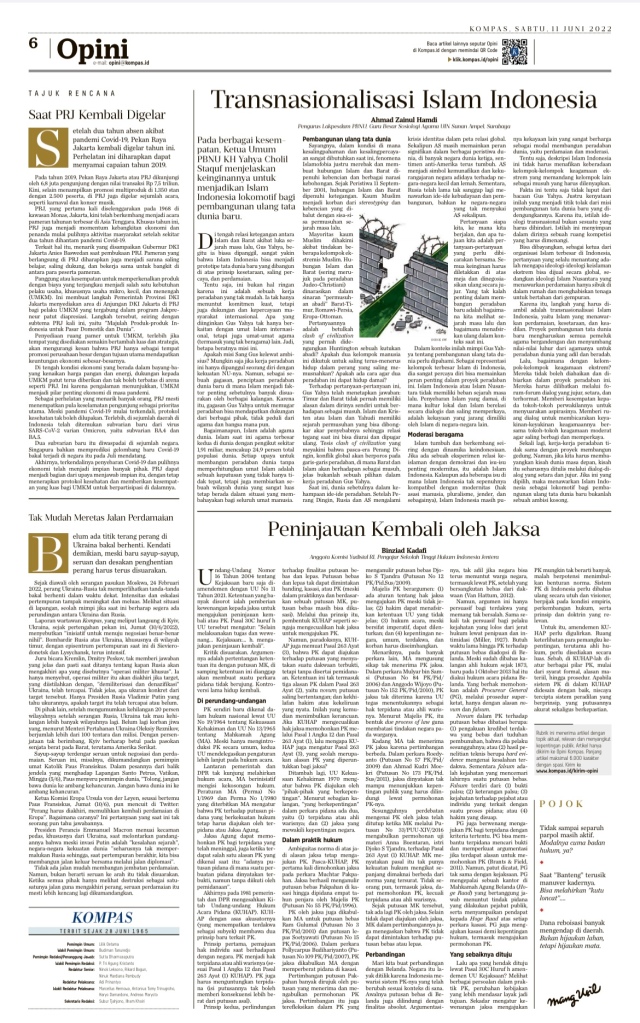

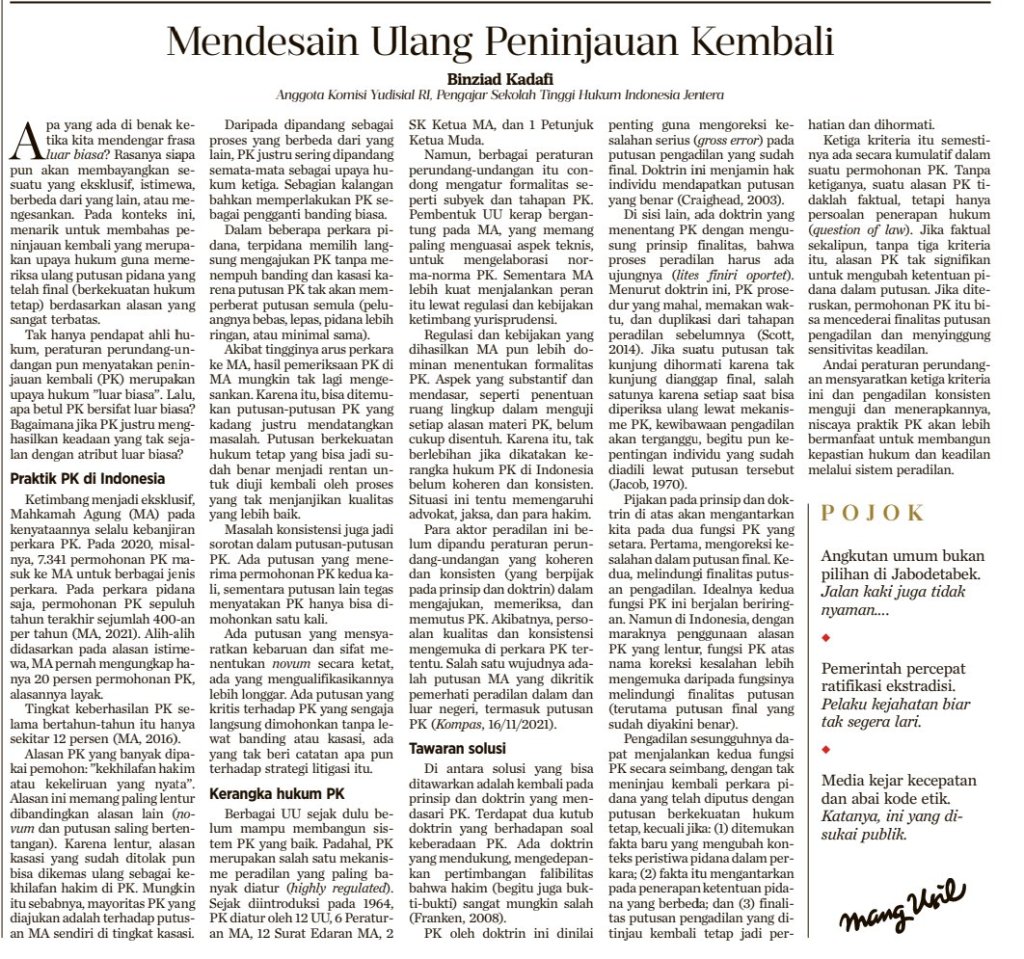
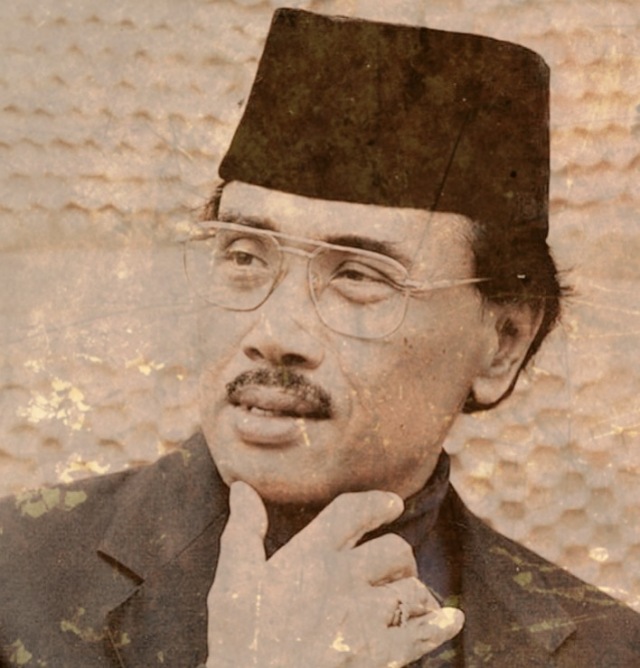
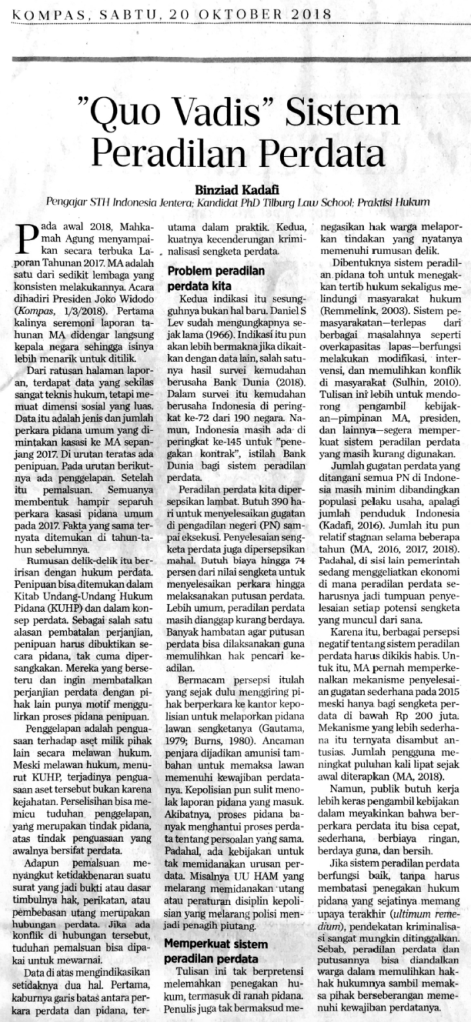
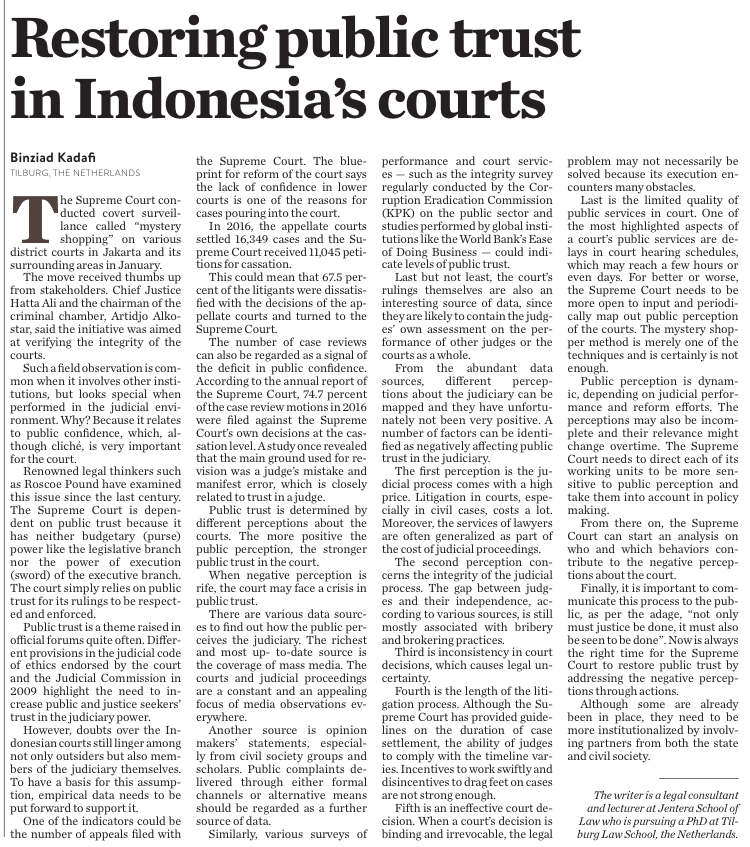
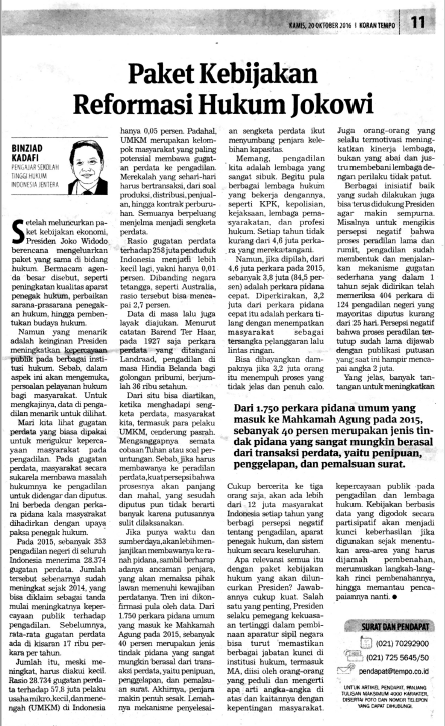
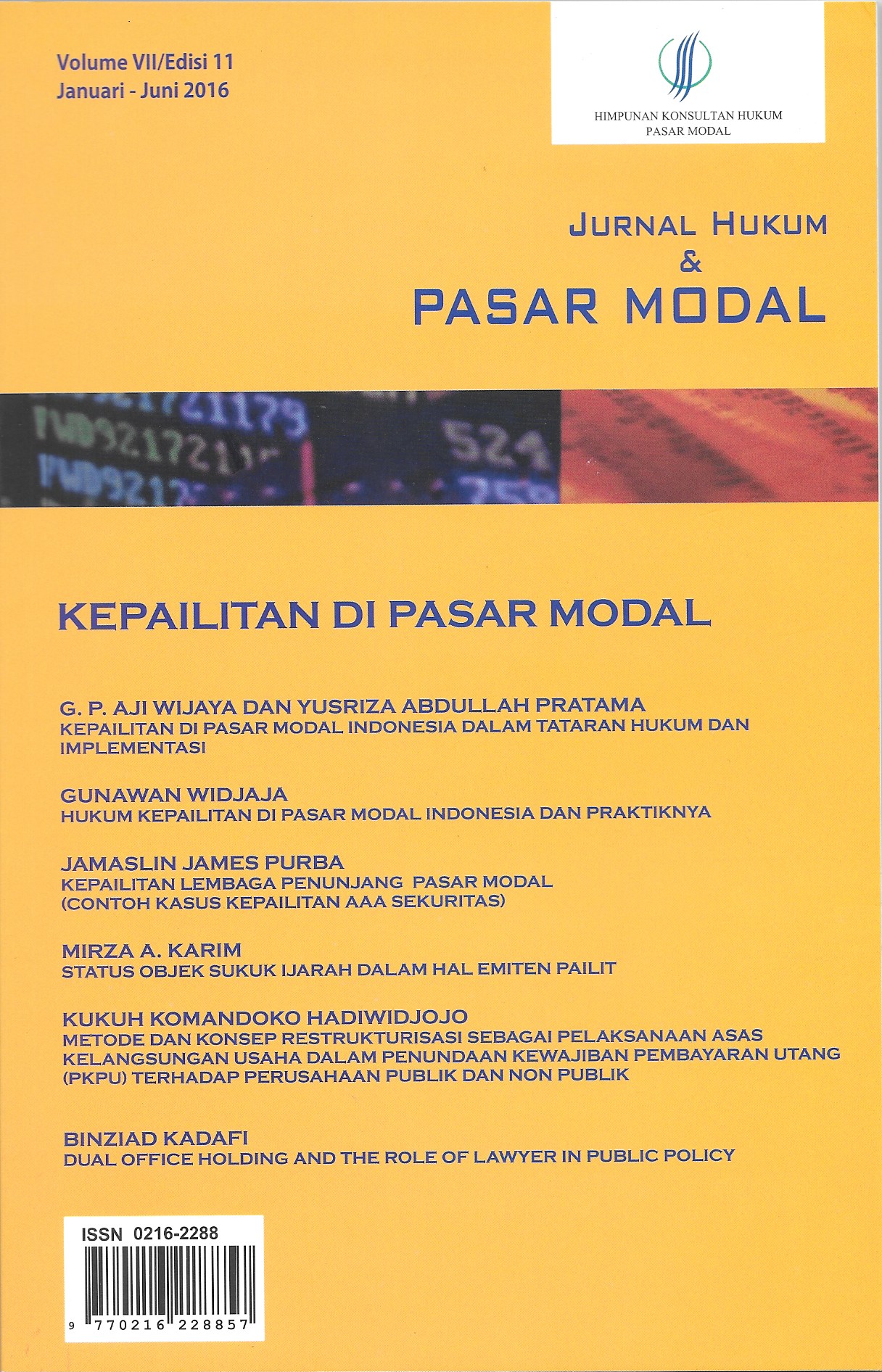
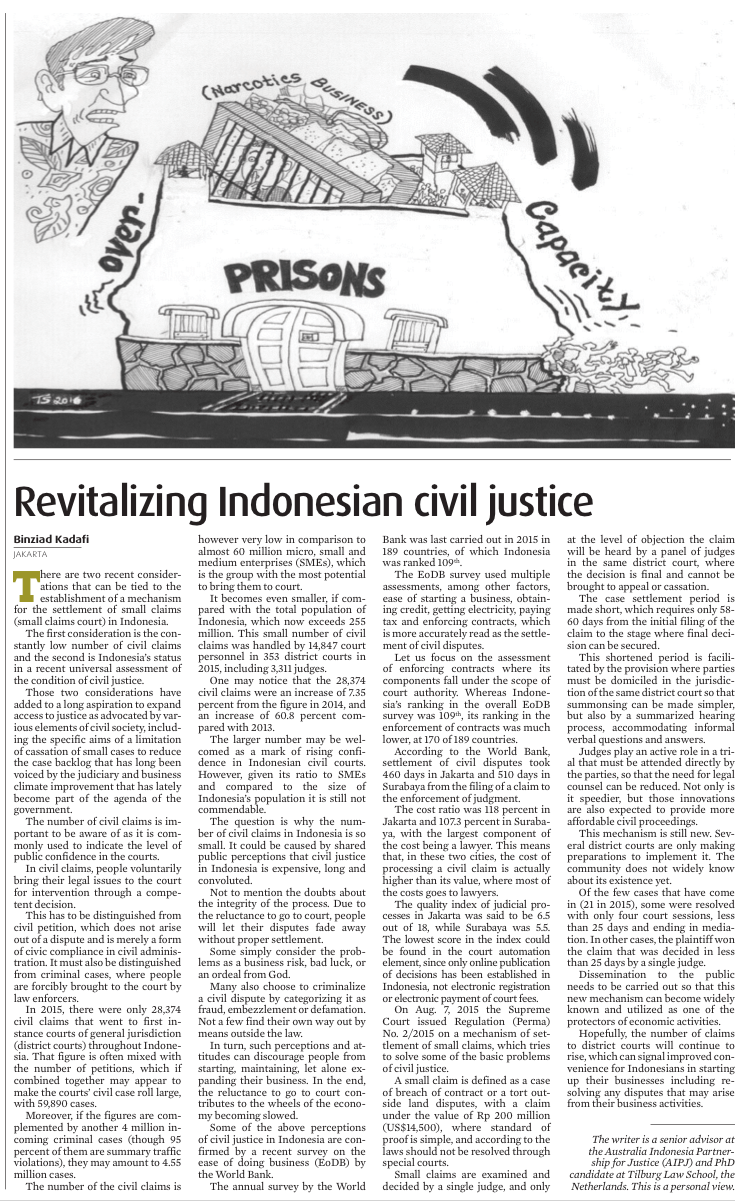


 The most rich, complete, and up-to-date source of data is media spotlight. Everywhere, not only in Indonesia, including in the Netherlands, the judiciary and adjudication are the subjects of permanent attention by the media. The attention of the media towards the court in Indonesia has been augmented recently following the improved transparency of decisions promoted by the Supreme Court through its successful efforts to make the full texts of court decisions available to the public online. Many times, not only bad news, but positive appreciation towards individual judges or the court institutionally can be obtained from media exposure. However, anticipation should be made on the potential bias of certain media, especially when they have, either directly or indirectly, interests in particular outcomes from the coverage. The proper strategy in overcoming this issue is by referring to different newspapers, magazines, and electronic media as references, so their reportage can be cross-checked one against the another, and by being aware of the important role of local media, which occasionally have more direct connections to the source of the news and their audiences.
The most rich, complete, and up-to-date source of data is media spotlight. Everywhere, not only in Indonesia, including in the Netherlands, the judiciary and adjudication are the subjects of permanent attention by the media. The attention of the media towards the court in Indonesia has been augmented recently following the improved transparency of decisions promoted by the Supreme Court through its successful efforts to make the full texts of court decisions available to the public online. Many times, not only bad news, but positive appreciation towards individual judges or the court institutionally can be obtained from media exposure. However, anticipation should be made on the potential bias of certain media, especially when they have, either directly or indirectly, interests in particular outcomes from the coverage. The proper strategy in overcoming this issue is by referring to different newspapers, magazines, and electronic media as references, so their reportage can be cross-checked one against the another, and by being aware of the important role of local media, which occasionally have more direct connections to the source of the news and their audiences.